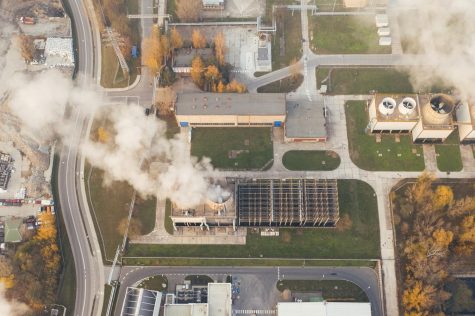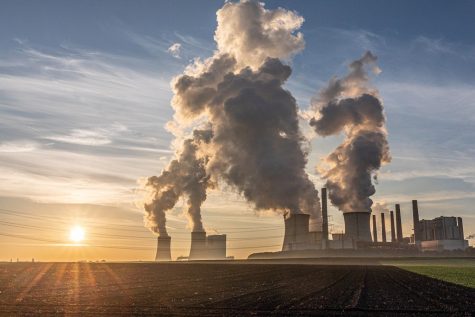OPINION: Shall I compare thee to a leaf?
*Columns are the opinions of their respective authors and do not necessarily reflect the views of The Wichitan as an organization.*
Summer is officially over and it’s been six years since I’ve been a part of the traditional experience of the changing of seasons. Traditional in the sense that one would experience the environmental distinction between winter, spring, summer and then fall. This differs from my recent acquaintance with the “seasons” having been living in sunny skied Miami where green palm trees and crushing humidity is plentiful year-round. One would think that my growing up in Wichita Falls, Texas would give me an affinity for embracing the gradual decline in temperature and sun, however throughout the years, when I would visit my family here during the holidays, the change of the seasons were already established. I would experience the climate during its peak and then jump to the next season bypassing the tedious in-between weather. Now living back in my hometown, in the morning that I am writing this piece I am mesmerized by the partial yellow beginning to reveal itself in the trees in my backyard, with their leaves slowly drifting from the tree to the ground. I am watching the seasons change in real time.
This process called senescence may seem mundane and just an event that happens in the background of our lives. However, as I brushed up on freshman biology and began to re-familiarize myself with the scientific processes that make up seasonal change, I found that we are not so different from the leaves.
How do leaves get those vibrant reds, oranges, and yellows that dictate the arrival of autumn?
I’ll spare you the headache, and give you the cliff notes version.
Each color that is physically shown has an important job in the particular life stage of the plant. Chlorophyll, (which gives us the green leaves) captures the energy in sunlight, and converts sunlight to food. During fall there is less sunlight and therefore less chlorophyll. Without energy the leaves don’t have a job to do. That’s when we see Mother Nature do her magic.
Leaves have pigmentation chemicals such as carotenoids and anthocyanin that showcase those wonderful shades of fall we know and love. The chemicals are always present, even in the summer and have specific roles in the life cycle of the plant. When the plant can no longer synthesize chlorophyll, the plant then produces sugars and amino acids that act as an antifreeze for the plant’s preservation. The tree is conserving its energy and now using the chemicals that were visually dormant to survive during the winter.
I may be a science nerd, but I think that plant cycle is fascinating and beautiful.
While fall may be beautiful to observe, the actual transition of change makes me uncomfortable. Fall has a reputation for being a fairly popular season. What’s not to like? You have the fore-mentioned incredible color changing of the leaves, pumpkin spice lattes (I am not embarrassed to like them!) sweater weather, and new relationship coupling season. Overall, I agree, but something about the in-between of fall gives me an eerie and unsettling feeling in the pit of my stomach.
Initially, my quarrel is with the beginning of fall. With the first little cold front there is a feeling of excitement that I can finally wear my favorite sweater that hides the quarantine weight I’ve gained. But by the afternoon I’m sweating again and need an iced tea to cope with the betrayal from the forecast. So my message to fall would be to choose a lane and be either cool or warm! Don’t make me experience the inconvenience of preparing for two seasons in one day.
As autumn progresses into a more consistent climate, the seasonal affective disorder begins to kick in. Stores have bypassed Halloween and Thanksgiving, prematurely started playing Jingle Bell Rock and putting up Christmas decorations. Holiday season is approaching and that means the inevitable stressful family season is riding shotgun.
The holidays and my family are not necessarily bad, just complicated. Riddled with divorce, scattered family members across the country, missed phone calls or texts, you know, the messy things that every dysfunctional family deals with across America are amplified during the holidays. I want to prolong the need to mentally and emotionally prepare myself for family obligations and reunions. I dread the questions asked by immediate and extended relatives.
“When are you getting married?”
“What are your plans for life?”
“You need to do X,Y, and Z to be successful”
Questions that I do not care to respond to nor have the answers for. But I know, once those leaves change and start falling, I need to start coming up with answers. Anxiety fires up the feeling that I need to catch up and produce something, anything, worthwhile that I believe will satisfy the imposed status quo of a productive and “acceptable” lifestyle. Fall reminds me that it’s not enough.
Then I remembered the leaves. They adapt, protect, and prepare for change. Witnessing this slow and gradual change has made me connect myself with the process.
Nature is aware of the changes that occur in our environment, as are our bodies. If nature preserves itself through rest in “dormancy” yet, is a longstanding successful process, then I can be too. If producing energy constantly to bear the fruit of green leaves is not feasible for nature, why do humans expect that we need to output a universal standard level of productivity? The colors that a leaf manifests at different times are all present continually in its genetic makeup. The coveted colors are always there, but it’s not their job to be on the forefront at all times, nor do we expect them to be. The same way our “colors” displayed in ones-self also have important roles, and in their time flourish and shine.
The leaves will, like all things in the circle of life, fall and die. Fall can be uncomfortable because we know that the trees will soon turn bare. But we do not despise when the leaves fall, because we know that they will emerge young and green soon enough. The purpose of our dying in the leaves is the shedding of ourselves into the compost of what we will grow anew. So let the leaves die and discern that although sometimes painfully, that as with all things beauty and change comes at a price. Embrace the change of the known or unknown. You, like nature, will adapt. No matter your relationship with autumn and natural or environmental factors that come with it, the fall season signals a change from the earth and we respond to it. Our bodies are primed for change. There’s a congruence with the notion in nature that nothing ever stands still, that nothing ever maintains its current identity or shape for long. All we can do is enjoy the varying, different, beautiful colors.














